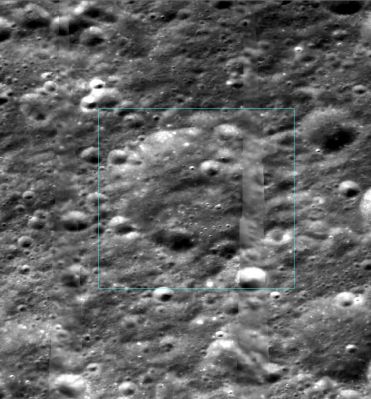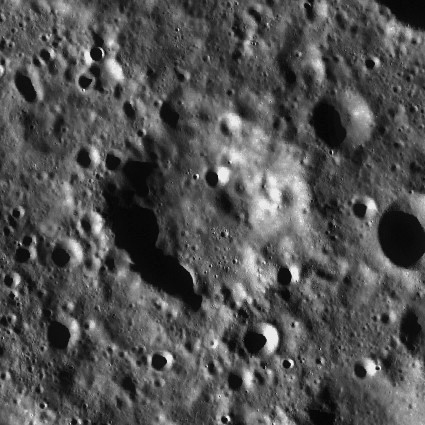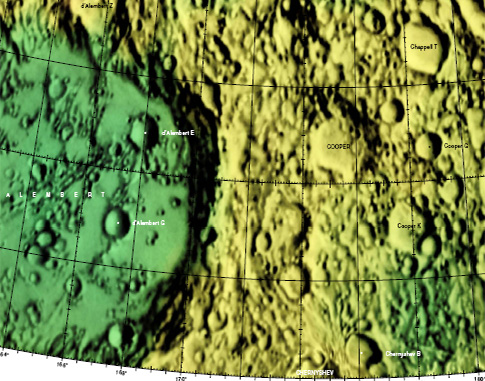Difference between revisions of "Cooper"
| (One intermediate revision by the same user not shown) | |||
| Line 5: | Line 5: | ||
|- | |- | ||
| | | | ||
| − | [http://lpod.org/coppermine/displayimage.php?pid=4303&fullsize=1 [[Image: | + | [http://lpod.org/coppermine/displayimage.php?pid=4303&fullsize=1 [[Image:Normal_cooper-large.jpg|external image normal_cooper-large.jpg]]][[Image:Cooper.jpg|Cooper.jpg]]<br /> |
| | | | ||
| − | [[Image: | + | [[Image:Cooper-color.jpg|cooper-color.jpg]]<br /> |
|} | |} | ||
''left:'' '''[http://www.lpi.usra.edu/resources/lunarorbiter/ Clementine]''' . ''center: '''LROC'''''<br /> ''right:'' [http://planetarynames.wr.usgs.gov/images/Lunar/lac_18.pdf Color-coded topography LAC 18] image from [http://the-moon.us/wiki/USGS%20Digital%20Atlas USGS Digital Atlas].<br /> <div id="toc"> | ''left:'' '''[http://www.lpi.usra.edu/resources/lunarorbiter/ Clementine]''' . ''center: '''LROC'''''<br /> ''right:'' [http://planetarynames.wr.usgs.gov/images/Lunar/lac_18.pdf Color-coded topography LAC 18] image from [http://the-moon.us/wiki/USGS%20Digital%20Atlas USGS Digital Atlas].<br /> <div id="toc"> | ||
| Line 16: | Line 16: | ||
''([http://the-moon.us/wiki/LAC%20zone LAC zone] 18C1)'' [http://planetarynames.wr.usgs.gov/images/Lunar/lac_18.pdf USGS Digital Atlas PDF]<br /> <br /> | ''([http://the-moon.us/wiki/LAC%20zone LAC zone] 18C1)'' [http://planetarynames.wr.usgs.gov/images/Lunar/lac_18.pdf USGS Digital Atlas PDF]<br /> <br /> | ||
==Description== | ==Description== | ||
| − | '''Cooper''' lies some 100 km away east of [http://the-moon.us/wiki/D%27Alembert D'Alembert] crater -- a 248 kilometre-wide crater of the [http://the-moon.us/wiki/Stratigraphy Nectarian] (~ 3.92 to 3.85 bn years) period. From its appearance '''Cooper''' is older than Nectarian, as nearly all of its rim and floor regions show signs of degradation, bombardment, and a recipient of ejecta deposits from, for example, [http://the-moon.us/wiki/Mare%20Moscoviense Mare Moscoviense] nearby to its south-west. Nearly all of the crater's original rim has been obliterated by numerous small impacts -- particularly at its eastern sectors, while its floor show characterisitcs of reshapement, re-mixing of in-situ materials with above-mentioned ejecta deposits; burying, perhaps, a history of the crater itself. <span class="membersnap">- | + | '''Cooper''' lies some 100 km away east of [http://the-moon.us/wiki/D%27Alembert D'Alembert] crater -- a 248 kilometre-wide crater of the [http://the-moon.us/wiki/Stratigraphy Nectarian] (~ 3.92 to 3.85 bn years) period. From its appearance '''Cooper''' is older than Nectarian, as nearly all of its rim and floor regions show signs of degradation, bombardment, and a recipient of ejecta deposits from, for example, [http://the-moon.us/wiki/Mare%20Moscoviense Mare Moscoviense] nearby to its south-west. Nearly all of the crater's original rim has been obliterated by numerous small impacts -- particularly at its eastern sectors, while its floor show characterisitcs of reshapement, re-mixing of in-situ materials with above-mentioned ejecta deposits; burying, perhaps, a history of the crater itself. <span class="membersnap">- JohnMoore2</span><br /> <br /> |
==Description: Wikipedia== | ==Description: Wikipedia== | ||
[http://en.wikipedia.org/wiki/Cooper_(crater) Cooper]<br /> <br /> | [http://en.wikipedia.org/wiki/Cooper_(crater) Cooper]<br /> <br /> | ||
Latest revision as of 20:08, 16 April 2018
Contents
Cooper
| Lat: 52.9°N, Long: 175.6°E, Diam: 36 km, Depth: km, Rükl: (farside) | |
right: Color-coded topography LAC 18 image from USGS Digital Atlas.
Images
LPOD Photo Gallery Lunar Orbiter Images
Maps
(LAC zone 18C1) USGS Digital Atlas PDF
Description
Cooper lies some 100 km away east of D'Alembert crater -- a 248 kilometre-wide crater of the Nectarian (~ 3.92 to 3.85 bn years) period. From its appearance Cooper is older than Nectarian, as nearly all of its rim and floor regions show signs of degradation, bombardment, and a recipient of ejecta deposits from, for example, Mare Moscoviense nearby to its south-west. Nearly all of the crater's original rim has been obliterated by numerous small impacts -- particularly at its eastern sectors, while its floor show characterisitcs of reshapement, re-mixing of in-situ materials with above-mentioned ejecta deposits; burying, perhaps, a history of the crater itself. - JohnMoore2
Description: Wikipedia
Additional Information
Nomenclature
John Cobb; American jurist, scholar (1887-1967).
LPOD Articles
Bibliography


